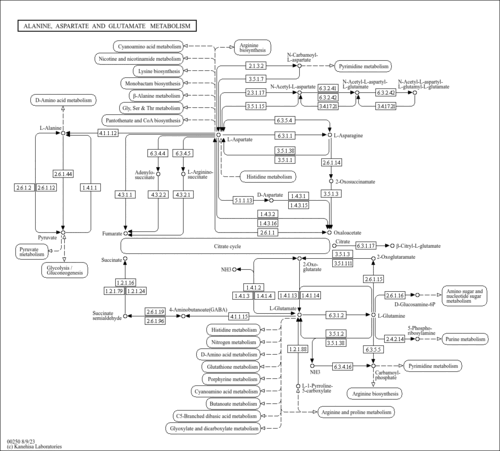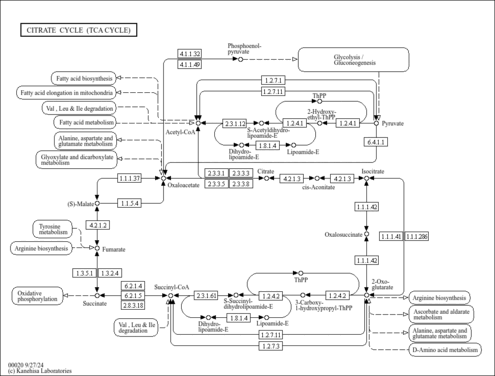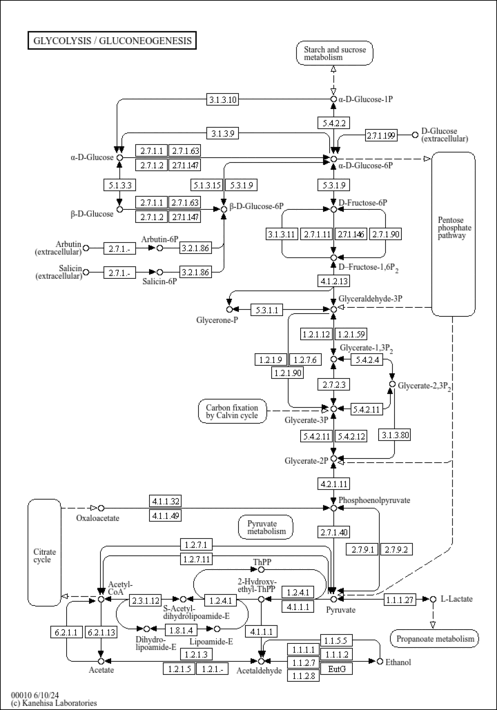| Record Information |
|---|
| Version | 1.0 |
|---|
| Created at | 2020-04-17 18:40:33 UTC |
|---|
| Updated at | 2020-11-18 16:38:47 UTC |
|---|
| CannabisDB ID | CDB004824 |
|---|
| Secondary Accession Numbers | Not Available |
|---|
| Cannabis Compound Identification |
|---|
| Common Name | Oxalacetic acid |
|---|
| Description | Oxalacetic acid, also known as oxaloacetate or 2-oxosuccinate, belongs to the class of organic compounds known as short-chain keto acids and derivatives. These are keto acids with an alkyl chain the contains less than 6 carbon atoms. Oxalacetic acid is a very hydrophobic molecule, practically insoluble (in water), and relatively neutral. Oxalacetic acid exists in all living species, ranging from bacteria to humans. Within humans, oxalacetic acid participates in a number of enzymatic reactions. In particular, oxalacetic acid can be biosynthesized from D-aspartic acid through the action of the enzyme D-aspartate oxidase. In addition, oxalacetic acid can be biosynthesized from D-aspartic acid through the action of the enzyme D-aspartate oxidase. In humans, oxalacetic acid is involved in the metabolic disorder called the canavan disease pathway. Outside of the human body, Oxalacetic acid has been detected, but not quantified in, several different foods, such as chinese mustards, lowbush blueberries, brassicas, maitakes, and kombus. This could make oxalacetic acid a potential biomarker for the consumption of these foods. An oxodicarboxylic acid that is succinic acid bearing a single oxo group. Oxalacetic acid is expected to be in Cannabis as all living plants are known to produce and metabolize it. |
|---|
| Structure | |
|---|
| Synonyms | | Value | Source |
|---|
| 2-Oxobutanedioic acid | ChEBI | | 2-Oxosuccinic acid | ChEBI | | 3-Carboxy-3-oxopropanoic acid | ChEBI | | Keto-succinic acid | ChEBI | | Ketosuccinic acid | ChEBI | | OAA | ChEBI | | Oxobutanedioic acid | ChEBI | | Oxosuccinic acid | ChEBI | | Oxaloacetic acid | Kegg | | Keto-oxaloacetate | Kegg | | 2-Oxobutanedioate | Generator | | 2-Oxosuccinate | Generator | | 3-Carboxy-3-oxopropanoate | Generator | | Keto-succinate | Generator | | Ketosuccinate | Generator | | Oxobutanedioate | Generator | | Oxosuccinate | Generator | | Oxaloacetate | Generator | | Keto-oxaloacetic acid | Generator | | Oxalacetate | Generator | | 2-Ketosuccinate | HMDB | | 2-Ketosuccinic acid | HMDB | | a-Ketosuccinate | HMDB | | a-Ketosuccinic acid | HMDB | | alpha-Ketosuccinate | HMDB | | alpha-Ketosuccinic acid | HMDB | | Oxaloethanoate | HMDB | | Oxaloethanoic acid | HMDB | | Acid, oxaloacetic | HMDB | | Acid, oxalacetic | HMDB | | 2 Ketosuccinic acid | HMDB | | 2 oxo Butanedioic acid | HMDB | | 2-oxo-Butanedioic acid | HMDB |
|
|---|
| Chemical Formula | C4H4O5 |
|---|
| Average Molecular Weight | 132.07 |
|---|
| Monoisotopic Molecular Weight | 132.0059 |
|---|
| IUPAC Name | 2-oxobutanedioic acid |
|---|
| Traditional Name | oxalacetate |
|---|
| CAS Registry Number | 328-42-7 |
|---|
| SMILES | OC(=O)CC(=O)C(O)=O |
|---|
| InChI Identifier | InChI=1S/C4H4O5/c5-2(4(8)9)1-3(6)7/h1H2,(H,6,7)(H,8,9) |
|---|
| InChI Key | KHPXUQMNIQBQEV-UHFFFAOYSA-N |
|---|
| Chemical Taxonomy |
|---|
| Description | Belongs to the class of organic compounds known as short-chain keto acids and derivatives. These are keto acids with an alkyl chain the contains less than 6 carbon atoms. |
|---|
| Kingdom | Organic compounds |
|---|
| Super Class | Organic acids and derivatives |
|---|
| Class | Keto acids and derivatives |
|---|
| Sub Class | Short-chain keto acids and derivatives |
|---|
| Direct Parent | Short-chain keto acids and derivatives |
|---|
| Alternative Parents | |
|---|
| Substituents | - Beta-keto acid
- Short-chain keto acid
- Alpha-keto acid
- Beta-hydroxy ketone
- Dicarboxylic acid or derivatives
- 1,3-dicarbonyl compound
- Alpha-hydroxy ketone
- Ketone
- Carboxylic acid
- Carboxylic acid derivative
- Carbonyl group
- Organooxygen compound
- Organic oxide
- Organic oxygen compound
- Hydrocarbon derivative
- Aliphatic acyclic compound
|
|---|
| Molecular Framework | Aliphatic acyclic compounds |
|---|
| External Descriptors | |
|---|
| Ontology |
|---|
|
| Physiological effect | Health effect: |
|---|
| Disposition | Route of exposure: Source: Biological location: |
|---|
| Physical Properties |
|---|
| State | Solid |
|---|
| Experimental Properties | | Property | Value | Reference |
|---|
| Melting Point | 161 °C | Not Available | | Boiling Point | Not Available | Not Available | | Water Solubility | 134 mg/mL | Not Available | | logP | Not Available | Not Available |
|
|---|
| Predicted Properties | [] |
|---|
| Spectra |
|---|
| EI-MS/GC-MS | | Type | Description | Splash Key | View |
|---|
| EI-MS | Mass Spectrum (Electron Ionization) | splash10-0006-9000000000-f371299a07d43c23ff1d | 2015-03-01 | View Spectrum | | GC-MS | Oxalacetic acid, non-derivatized, GC-MS Spectrum | splash10-00dr-4900000000-9d943d40beaca3c602a1 | Spectrum | | GC-MS | Oxalacetic acid, 1 MEOX; 2 TMS, GC-MS Spectrum | splash10-007a-9210000000-020f60717e2ea79d1ccd | Spectrum | | GC-MS | Oxalacetic acid, 1 MEOX; 2 TMS, GC-MS Spectrum | splash10-000b-9540000000-a53f674cc98960834f88 | Spectrum | | GC-MS | Oxalacetic acid, 1 MEOX; 3 TMS, GC-MS Spectrum | splash10-001a-8940000000-40b790e06141d7180938 | Spectrum | | GC-MS | Oxalacetic acid, non-derivatized, GC-MS Spectrum | splash10-007a-9210000000-020f60717e2ea79d1ccd | Spectrum | | GC-MS | Oxalacetic acid, non-derivatized, GC-MS Spectrum | splash10-000b-9540000000-a53f674cc98960834f88 | Spectrum | | GC-MS | Oxalacetic acid, non-derivatized, GC-MS Spectrum | splash10-001a-8940000000-40b790e06141d7180938 | Spectrum | | GC-MS | Oxalacetic acid, non-derivatized, GC-MS Spectrum | splash10-0002-4930000000-7e995327b0b9c1af0914 | Spectrum | | Predicted GC-MS | Oxalacetic acid, non-derivatized, Predicted GC-MS Spectrum - 70eV, Positive | splash10-000f-9100000000-6718417e7196063f9544 | Spectrum | | Predicted GC-MS | Oxalacetic acid, 2 TMS, Predicted GC-MS Spectrum - 70eV, Positive | splash10-00ds-9520000000-5a082ec8843f6fbc3b15 | Spectrum | | Predicted GC-MS | Oxalacetic acid, non-derivatized, Predicted GC-MS Spectrum - 70eV, Positive | Not Available | Spectrum | | Predicted GC-MS | Oxalacetic acid, non-derivatized, Predicted GC-MS Spectrum - 70eV, Positive | Not Available | Spectrum | | Predicted GC-MS | Oxalacetic acid, TMS_1_1, Predicted GC-MS Spectrum - 70eV, Positive | Not Available | Spectrum | | Predicted GC-MS | Oxalacetic acid, TMS_1_2, Predicted GC-MS Spectrum - 70eV, Positive | Not Available | Spectrum | | Predicted GC-MS | Oxalacetic acid, TMS_1_3, Predicted GC-MS Spectrum - 70eV, Positive | Not Available | Spectrum | | Predicted GC-MS | Oxalacetic acid, TMS_2_2, Predicted GC-MS Spectrum - 70eV, Positive | Not Available | Spectrum | | Predicted GC-MS | Oxalacetic acid, TMS_2_3, Predicted GC-MS Spectrum - 70eV, Positive | Not Available | Spectrum | | Predicted GC-MS | Oxalacetic acid, TBDMS_1_1, Predicted GC-MS Spectrum - 70eV, Positive | Not Available | Spectrum | | Predicted GC-MS | Oxalacetic acid, TBDMS_1_2, Predicted GC-MS Spectrum - 70eV, Positive | Not Available | Spectrum | | Predicted GC-MS | Oxalacetic acid, TBDMS_1_3, Predicted GC-MS Spectrum - 70eV, Positive | Not Available | Spectrum | | Predicted GC-MS | Oxalacetic acid, TBDMS_2_1, Predicted GC-MS Spectrum - 70eV, Positive | Not Available | Spectrum | | Predicted GC-MS | Oxalacetic acid, TBDMS_2_2, Predicted GC-MS Spectrum - 70eV, Positive | Not Available | Spectrum | | Predicted GC-MS | Oxalacetic acid, TBDMS_2_3, Predicted GC-MS Spectrum - 70eV, Positive | Not Available | Spectrum |
|
|---|
| MS/MS | | Type | Description | Splash Key | View |
|---|
| MS/MS | LC-MS/MS Spectrum - Quattro_QQQ 10V, Negative (Annotated) | splash10-000i-9000000000-0be675f3aa3e973393b7 | 2012-07-24 | View Spectrum | | MS/MS | LC-MS/MS Spectrum - Quattro_QQQ 25V, Negative (Annotated) | splash10-000f-9000000000-4fba97fcd7b0f2215f75 | 2012-07-24 | View Spectrum | | MS/MS | LC-MS/MS Spectrum - Quattro_QQQ 40V, Negative (Annotated) | splash10-0006-9000000000-9b1f4171aee6283a3cbd | 2012-07-24 | View Spectrum | | MS/MS | LC-MS/MS Spectrum - , negative | splash10-014i-0900000000-7c598fd9c78acb94dacd | 2017-09-14 | View Spectrum | | MS/MS | LC-MS/MS Spectrum - QTOF 3V, positive | splash10-014i-4900000000-e7803730ae7986a1b9fb | 2020-07-22 | View Spectrum | | MS/MS | LC-MS/MS Spectrum - QTOF 4V, positive | splash10-014r-5900000000-8e478338a7c0e65e62ba | 2020-07-22 | View Spectrum | | MS/MS | LC-MS/MS Spectrum - QTOF 5V, positive | splash10-014r-7900000000-f681763317e1ae86e691 | 2020-07-22 | View Spectrum | | MS/MS | LC-MS/MS Spectrum - QTOF 7V, positive | splash10-00kr-9600000000-aa8adf9a96041dddbbdd | 2020-07-22 | View Spectrum | | MS/MS | LC-MS/MS Spectrum - QTOF 10V, positive | splash10-000i-9200000000-e62c47ca2bc492900178 | 2020-07-22 | View Spectrum | | MS/MS | LC-MS/MS Spectrum - QTOF 15V, positive | splash10-000i-9000000000-5485ddd84a64ea0ca0b9 | 2020-07-22 | View Spectrum | | MS/MS | LC-MS/MS Spectrum - QTOF 17V, positive | splash10-000i-9000000000-79521cb04a2b23e39c1e | 2020-07-22 | View Spectrum | | MS/MS | LC-MS/MS Spectrum - QTOF 20V, positive | splash10-000m-9000000000-601c8d2ec63f8b01a61e | 2020-07-22 | View Spectrum | | MS/MS | LC-MS/MS Spectrum - QTOF 23V, positive | splash10-000e-9000000000-13d369c58d8930958d92 | 2020-07-22 | View Spectrum | | MS/MS | LC-MS/MS Spectrum - QTOF 25V, positive | splash10-0005-9000000000-df8387ef907fb71342eb | 2020-07-22 | View Spectrum | | MS/MS | LC-MS/MS Spectrum - QTOF 27V, positive | splash10-0005-9000000000-908644b5d7041346f582 | 2020-07-22 | View Spectrum | | MS/MS | LC-MS/MS Spectrum - QTOF 30V, positive | splash10-0005-9000000000-ecca787a800164d0296f | 2020-07-22 | View Spectrum | | MS/MS | LC-MS/MS Spectrum - QTOF 33V, positive | splash10-0005-9000000000-180a7c51b1f93cb8fff2 | 2020-07-22 | View Spectrum | | MS/MS | LC-MS/MS Spectrum - QTOF 35V, positive | splash10-0005-9000000000-709c49f609f5a711a288 | 2020-07-22 | View Spectrum | | MS/MS | LC-MS/MS Spectrum - QTOF 40V, positive | splash10-0005-9000000000-aa103ab9beb03bd6eb22 | 2020-07-22 | View Spectrum | | Predicted MS/MS | Predicted LC-MS/MS Spectrum - 10V, Positive | splash10-014i-3900000000-6f4e965a3f513bf8db13 | 2015-04-24 | View Spectrum | | Predicted MS/MS | Predicted LC-MS/MS Spectrum - 20V, Positive | splash10-014i-9600000000-8ae7abf60057088e14db | 2015-04-24 | View Spectrum | | Predicted MS/MS | Predicted LC-MS/MS Spectrum - 40V, Positive | splash10-01bc-9100000000-5724c215c46a4f568140 | 2015-04-24 | View Spectrum | | Predicted MS/MS | Predicted LC-MS/MS Spectrum - 10V, Negative | splash10-0019-8900000000-829898d0849b1fbf1c28 | 2015-04-25 | View Spectrum | | Predicted MS/MS | Predicted LC-MS/MS Spectrum - 20V, Negative | splash10-000i-9100000000-5a5ff8fb7cb52eebf0c8 | 2015-04-25 | View Spectrum | | Predicted MS/MS | Predicted LC-MS/MS Spectrum - 40V, Negative | splash10-0006-9000000000-657d1384d478ddc33b6d | 2015-04-25 | View Spectrum |
|
|---|
| NMR | | Type | Description | | View |
|---|
| 1D NMR | 1H NMR Spectrum (1D, 500 MHz, H2O, experimental) | | Spectrum | | 1D NMR | 1H NMR Spectrum (1D, 800 MHz, Sodium phosphate (pH 7.4) in 90% H2O /10% D2O, experimental) | | Spectrum | | 1D NMR | 1H NMR Spectrum (1D, 100 MHz, D2O, predicted) | | Spectrum | | 1D NMR | 13C NMR Spectrum (1D, 100 MHz, D2O, predicted) | | Spectrum | | 1D NMR | 1H NMR Spectrum (1D, 1000 MHz, D2O, predicted) | | Spectrum | | 1D NMR | 13C NMR Spectrum (1D, 1000 MHz, D2O, predicted) | | Spectrum | | 1D NMR | 1H NMR Spectrum (1D, 200 MHz, D2O, predicted) | | Spectrum | | 1D NMR | 13C NMR Spectrum (1D, 200 MHz, D2O, predicted) | | Spectrum | | 1D NMR | 1H NMR Spectrum (1D, 300 MHz, D2O, predicted) | | Spectrum | | 1D NMR | 13C NMR Spectrum (1D, 300 MHz, D2O, predicted) | | Spectrum | | 1D NMR | 1H NMR Spectrum (1D, 400 MHz, D2O, predicted) | | Spectrum | | 1D NMR | 13C NMR Spectrum (1D, 400 MHz, D2O, predicted) | | Spectrum | | 1D NMR | 1H NMR Spectrum (1D, 500 MHz, D2O, predicted) | | Spectrum | | 1D NMR | 13C NMR Spectrum (1D, 500 MHz, D2O, predicted) | | Spectrum | | 1D NMR | 1H NMR Spectrum (1D, 600 MHz, D2O, predicted) | | Spectrum | | 1D NMR | 13C NMR Spectrum (1D, 600 MHz, D2O, predicted) | | Spectrum | | 1D NMR | 1H NMR Spectrum (1D, 700 MHz, D2O, predicted) | | Spectrum | | 1D NMR | 13C NMR Spectrum (1D, 700 MHz, D2O, predicted) | | Spectrum | | 1D NMR | 1H NMR Spectrum (1D, 800 MHz, D2O, predicted) | | Spectrum | | 1D NMR | 13C NMR Spectrum (1D, 800 MHz, D2O, predicted) | | Spectrum | | 1D NMR | 1H NMR Spectrum (1D, 900 MHz, D2O, predicted) | | Spectrum | | 1D NMR | 13C NMR Spectrum (1D, 900 MHz, D2O, predicted) | | Spectrum | | 2D NMR | [1H, 13C]-HSQC NMR Spectrum (2D, 600 MHz, H2O, experimental) | | Spectrum | | 2D NMR | [1H, 13C] NMR Spectrum (2D, 800 MHz, experimental) | | Spectrum |
|
|---|
| Pathways |
|---|
| Pathways | | Name | SMPDB/Pathwhiz | KEGG | | Alanine Metabolism |    |  | | Malate-Aspartate Shuttle |    | Not Available | | Citric Acid Cycle |    |  | | Gluconeogenesis |    |  | | Aspartate Metabolism |    |  |
|
|---|
| Protein Targets |
|---|
| Enzymes | |
|---|
| Transporters | Not Available |
|---|
| Metal Bindings | |
|---|
| Receptors | Not Available |
|---|
| Transcriptional Factors | Not Available |
|---|
| Concentrations Data |
|---|
| Not Available |
|---|
| External Links |
|---|
| HMDB ID | HMDB0000223 |
|---|
| DrugBank ID | Not Available |
|---|
| Phenol Explorer Compound ID | Not Available |
|---|
| FoodDB ID | FDB031075 |
|---|
| KNApSAcK ID | C00001197 |
|---|
| Chemspider ID | 945 |
|---|
| KEGG Compound ID | C00036 |
|---|
| BioCyc ID | OXALACETIC_ACID |
|---|
| BiGG ID | 33604 |
|---|
| Wikipedia Link | Oxaloacetic_acid |
|---|
| METLIN ID | 123 |
|---|
| PubChem Compound | 970 |
|---|
| PDB ID | Not Available |
|---|
| ChEBI ID | 30744 |
|---|
| References |
|---|
| General References | Not Available |
|---|


